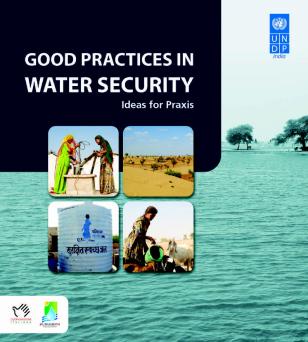Good Practices in Water Security: Ideas for Praxis
Good Practices in Water Security: Ideas for Praxis
February 20, 2013
A repository on good practices that address the challenge of water scarcity, the publication outlines how a joint project in Rajasthan has resulted in a 140 percent decline in expenditure costs per household.
Good Practices in Water Security: Ideas for Praxis is a compendium of best practices that are an outcome of a five-year project -- ‘Vulnerability Reduction through Community Empowerment and Control of Water in Marwar Region’. The project was funded by the Italian Development Cooperation and implemented by the Jal Bhagirathi Foundation with techno-managerial support from the United Nations Development Programme. It was implemented in 200 villages spread across 2,500 kms in Pali, Barmer and Jodhpur districts of the Marwar region.
Marwar, in the Thar Desert of western Rajasthan, is the most densely populated desert in the world. It has the lowest water endowment in Rajasthan, which itself is in a zone of extreme water scarcity. Marwar is a land of extremes with low annual rainfall, nonperennial rivers, saline groundwater and extreme temperatures.
It has also been identified as one of the most vulnerable areas of India to be adversely affected by global warming. Due to these adverse conditions, the people of Marwar have for long struggled to access drinking water. The situation of acute water scarcity has led to the drudgery of women and children, especially the girl child. Moreover, the people of this water-scarce land are forced to buy water resulting in enormous financial strain.
To address these vulnerabilities, the five-year project which adopts a people-oriented approach was rolled out. This approach evolved around developing solutions to water problems from within the community itself and involving people in construction and conservation of water structures and sources. Purposive action was taken in order to mobilise, empower and build capacities of people to achieve water security.
Communities in more than 200 villages were galvanised and organised into water institutions to restore/build and manage water harvesting systems. About 291 water harvesting structures were restored and/or built. Women and the marginalised community were empowered to participate in water management of their villages. A decentralised system of social governance was set up and community-level social capital was built by forming effective and accountable village water user associations called Jal Sabhas to plan, manage and implement micro projects.
Through contributory Jal Kosh (water development and management fund) communities were able to maintain bank accounts to collect money for carrying out sustenance and maintenance activities. Local leadership was encouraged for sustainable development and water security in the region.
The project improved the overall availability and access to water for around 300,000 people. The interventions led to the creation of women’s Jal Sabhas and Jal Mandals to ensure proactive participation of women in resolving their own water problems Formation of children Jal Dals provided an excellent example of volunteerism and community service, enabling children to learn about their environment through hands-on experiences in water management systems.
EXECUTIVE SUMMARY 06 Further, the facilitation of small water enterprises (SWEs) in villages as community-owned institutions has contributed to increased availability of inexpensive and safe drinking water. It has also proved to be a source of income for the water suppliers, especially for women, thus making people secure about access to water and also providing financial security.
It has also nurtured goal-directed, purposive social interaction wherein natural leaders organise their people into a meaningful, empowered social group. It ensures socialization of children as responsible future citizens of their country.
This document includes several case studies that illustrate the implementation of these strategies at the grassroots. Each aspect presented here has been chosen on the basis of proven results, effectiveness and sustainability, viability of costs/systems and scope for replication. These good practices assert ideas of praxis in water security by underscoring the concept of community management of water resources.
These cases talk about effective methods of building people’s institutions and how communities have evolved and imbibed new strategies of water management involving collective action and traditional wisdom thus laying the foundation of sustainability. It also showcases the benefits of linking water access to better hygiene and dignity by educating people on benefits of constructing their own sanitation facilities and thus promoting hygiene practices.
It is important to note that all of these practices are led by local communities themselves, while the project supported them only with necessary capacity development inputs and a part of financial burden. Therefore, any attempt to replicate these practices with a top down approach may not be fruitful.
This volume is expected to serve as a databank of good practices that could be taken up as a model approach for replication scale up not only in other parts of Marwar but also in other water stressed areas. Sharing of these practices is expected to result in wider networks and collaborations on the core issue of community led water management.

 Locations
Locations